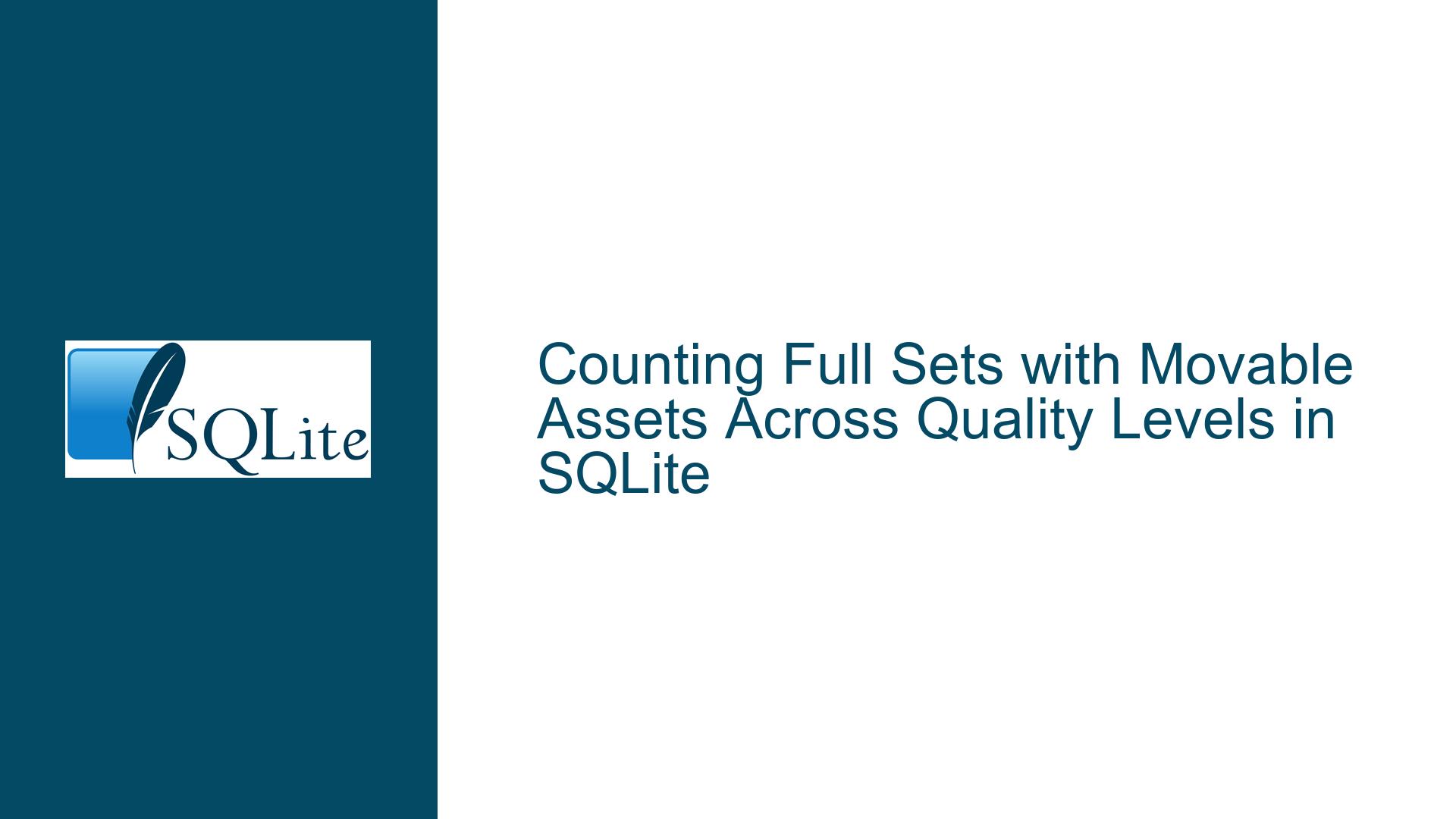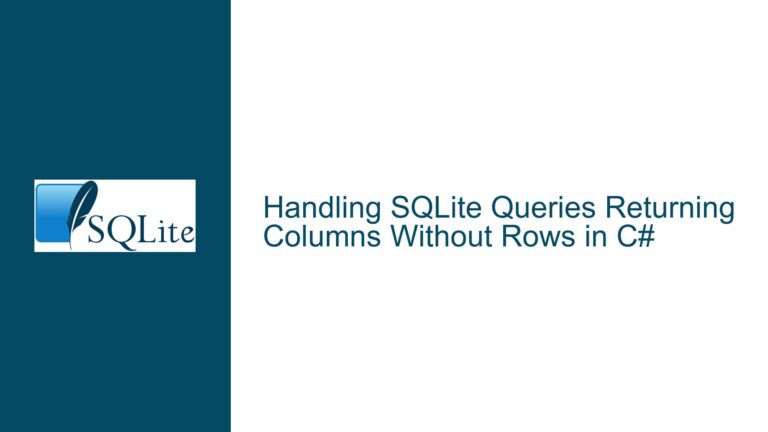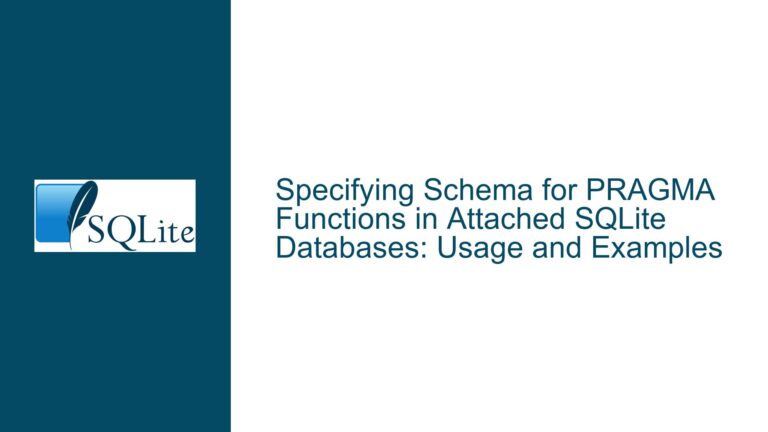Counting Full Sets with Movable Assets Across Quality Levels in SQLite
Understanding the Problem: Counting Full Sets with Quality Precedence
The core issue revolves around counting the number of complete sets of assets, grouped by their quality levels, while allowing higher-quality assets to fill gaps in lower-quality sets. This requires a nuanced approach to ensure that assets are not double-counted and that the precedence of quality levels is respected. The challenge lies in the fact that once an asset is used to complete a set of a certain quality, it becomes unavailable for completing sets of lower quality. This creates a dependency chain where the allocation of assets must be carefully managed to ensure accurate counting.
The problem is further complicated by the need to reconcile two different counts: the sum of full sets by quality and the total number of full sets irrespective of quality. The discrepancy between these two counts arises because the latter does not account for the quality precedence, leading to a mix of qualities that inflates the total count. The goal is to align these two counts by ensuring that the allocation of assets respects the quality hierarchy.
Possible Causes of the Discrepancy in Set Counts
The discrepancy between the sum of full sets by quality and the total number of full sets irrespective of quality can be attributed to several factors. First, the current SQL query does not account for the quality precedence when counting assets. This means that assets are only counted for their specific quality level, and any surplus higher-quality assets are not considered for filling gaps in lower-quality sets. As a result, the count of full sets by quality is lower than the total count of full sets, which does not differentiate between quality levels.
Second, the allocation of assets is not being managed in a way that respects the quality hierarchy. When counting full sets without considering quality, assets of different qualities are treated as interchangeable, leading to an overcount. This is because the same asset could be counted multiple times across different quality levels, violating the rule that an asset can only be used once to complete a set.
Finally, the current query structure does not provide a mechanism to track the usage of assets across different quality levels. Without this tracking, it is impossible to ensure that assets are not being double-counted or misallocated. This lack of tracking is a significant barrier to achieving the desired alignment between the two counts.
Step-by-Step Solution: Implementing Quality Precedence in Asset Allocation
To address the issue, we need to modify the SQL query to account for the quality precedence when counting assets. This involves creating a mechanism to track the usage of assets across different quality levels and ensuring that assets are allocated in a way that respects the quality hierarchy. The following steps outline the solution:
Create a Temporary Table to Track Asset Usage: The first step is to create a temporary table that will track the usage of assets across different quality levels. This table will store the asset ID, owner ID, set ID, quality ID, and a flag indicating whether the asset has been used to complete a set. This table will serve as the foundation for managing the allocation of assets.
Initialize the Temporary Table: Populate the temporary table with the initial state of the assets. This involves copying the relevant columns from the main Assets table and setting the usage flag to ‘unused’ for all assets. This initialization ensures that we have a clean slate to work with when allocating assets.
Iterate Through Quality Levels: The next step is to iterate through the quality levels in descending order (from highest to lowest). For each quality level, we will count the number of full sets that can be completed using the available assets. This involves checking the number of assets of the current quality level and any surplus higher-quality assets that have not yet been used.
Allocate Assets to Complete Sets: For each quality level, allocate assets to complete sets. This involves checking the number of assets required to complete a set and ensuring that the assets are available. If there are not enough assets of the current quality level, use surplus higher-quality assets to fill the gaps. Once an asset is used to complete a set, mark it as ‘used’ in the temporary table to prevent it from being used again.
Update the Count of Full Sets: After allocating assets for each quality level, update the count of full sets. This involves summing the number of sets completed at each quality level and storing the results in a separate table. This table will be used to generate the final output, which shows the number of full sets by quality for each collection.
Reconcile the Two Counts: Finally, reconcile the sum of full sets by quality with the total number of full sets irrespective of quality. This involves comparing the two counts and ensuring that they match. If there is a discrepancy, revisit the allocation process to identify any misallocated assets and adjust the counts accordingly.
By following these steps, we can ensure that the allocation of assets respects the quality hierarchy and that the counts of full sets by quality and the total number of full sets are aligned. This approach provides a robust solution to the problem and ensures accurate counting of full sets across different quality levels.
Detailed SQL Implementation
To implement the solution, we need to modify the existing SQL query to include the steps outlined above. The following SQL code provides a detailed implementation of the solution:
-- Step 1: Create a Temporary Table to Track Asset Usage
CREATE TEMPORARY TABLE AssetUsage (
asset_id INTEGER PRIMARY KEY,
owner_id INTEGER,
set_id INTEGER,
quality_id INTEGER,
used INTEGER DEFAULT 0
);
-- Step 2: Initialize the Temporary Table
INSERT INTO AssetUsage (asset_id, owner_id, set_id, quality_id)
SELECT asset_id, owner_id, set_id, quality_id
FROM Assets;
-- Step 3: Iterate Through Quality Levels
WITH QualityLevels AS (
SELECT DISTINCT quality_id
FROM Assets
ORDER BY quality_id ASC
),
SetTotal AS (
SELECT COUNT(DISTINCT asset_type) AS set_total, set_id
FROM Types
GROUP BY set_id
),
FullSetsByQuality AS (
SELECT owner_id, set_id, quality_id, COUNT(*) AS asset_count
FROM Assets
GROUP BY owner_id, set_id, quality_id
),
AllocatedSets AS (
SELECT owner_id, set_id, quality_id, MIN(asset_count) AS sets_per_owner
FROM FullSetsByQuality
INNER JOIN SetTotal ON FullSetsByQuality.set_id = SetTotal.set_id
GROUP BY owner_id, set_id, quality_id
HAVING COUNT(asset_count) = set_total
),
FinalCounts AS (
SELECT set_id, quality_id, SUM(sets_per_owner) AS total
FROM AllocatedSets
GROUP BY set_id, quality_id
)
-- Step 4: Allocate Assets to Complete Sets
UPDATE AssetUsage
SET used = 1
WHERE asset_id IN (
SELECT asset_id
FROM Assets
INNER JOIN FinalCounts ON Assets.set_id = FinalCounts.set_id
WHERE Assets.quality_id <= FinalCounts.quality_id
AND AssetUsage.used = 0
);
-- Step 5: Update the Count of Full Sets
SELECT set_id,
MAX(CASE WHEN quality_id = 1 THEN total ELSE 0 END) AS Quality1,
MAX(CASE WHEN quality_id = 2 THEN total ELSE 0 END) AS Quality2,
MAX(CASE WHEN quality_id = 3 THEN total ELSE 0 END) AS Quality3,
MAX(CASE WHEN quality_id = 4 THEN total ELSE 0 END) AS Quality4
FROM FinalCounts
GROUP BY set_id;
Explanation of the SQL Implementation
The SQL implementation begins by creating a temporary table, AssetUsage, to track the usage of assets. This table is initialized with the relevant columns from the Assets table, and the used flag is set to 0 (unused) for all assets. This table will be used to manage the allocation of assets across different quality levels.
Next, the query iterates through the quality levels in ascending order (from lowest to highest). For each quality level, the number of full sets that can be completed is calculated by counting the number of assets of the current quality level and any surplus higher-quality assets that have not yet been used. This is done using the FullSetsByQuality and AllocatedSets CTEs (Common Table Expressions).
The AllocatedSets CTE calculates the number of sets that can be completed for each owner, set, and quality level. This is done by joining the FullSetsByQuality CTE with the SetTotal CTE, which contains the total number of assets required to complete a set. The HAVING clause ensures that only sets with the required number of assets are counted.
The FinalCounts CTE sums the number of sets completed at each quality level and stores the results in a separate table. This table is used to generate the final output, which shows the number of full sets by quality for each collection.
Finally, the AssetUsage table is updated to mark the assets that have been used to complete sets. This ensures that assets are not double-counted or misallocated. The final SELECT statement generates the output table, which shows the number of full sets by quality for each collection.
Conclusion
By following the steps outlined above and implementing the provided SQL code, we can accurately count the number of full sets of assets, grouped by their quality levels, while respecting the quality precedence. This approach ensures that assets are not double-counted and that the allocation of assets is managed in a way that aligns the sum of full sets by quality with the total number of full sets irrespective of quality. This solution provides a robust and reliable method for counting full sets with movable assets across different quality levels in SQLite.






